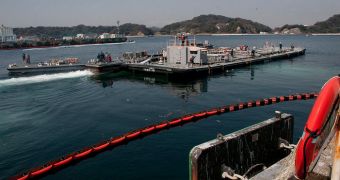A couple of days ago, Japanese authorities detected a crack in the reactor 2 building at the Fukushima Daiichi nuclear power plant. Through the 20-centimeter (7.9-inch) hole, highly-radioactive water is spilling into the Pacific Ocean, and experts are scrambling to fix the issue.
The contaminated water found to be coming out of the reactor contains one million Becquerels per liter of the highly radioactive compound iodine 131. According to experts, water concentrations of this isotope are 10,000 times higher than what experts could expect to find near a nuclear power plant.
Officials have announced on Friday, April 2, that the runoff water is emitting radiation at a rate of 1 Sievert (Sv) per hour. The crack releasing this water was discovered in a ditch containing electrical cables. The structure is located near the reactor 2 seawater inlet.
Yesterday, April 3, the Tokyo Electric Power Company (TEPCO) attempted to fill in the crack using concrete, but the material did not hold. They then considered pouring an advanced type of resin, but the plan was subsequently abandoned.
The next attempt to seal the leak use a mixture of sawdust, shredded newspapers and other chemicals, but that did not work either. TEPCO officials also announced that it would take several months before the situation unfolding at Fukushima is resolved.
“It would take a few months until we finally get things under control and have a better idea about the future. We'll face a crucial turning point within the next few months, but that is not the end,” told reporters Nuclear and Industrial Safety Agency (NISA) spokesman Hidehiko Nishiyama.
The first priority is to redirect the flow of contaminated water from the ocean into special-purpose tankers, that could then dispose of it properly. As soon as this is done, the second priority will kick in – restoring fully-functional cooling capabilities to all the reactors.
On Sunday, emergency responders working in the basement of the reactor 4 building found the bodies of two Fukushima workers, who had been missing since March 11. They apparently died due to severe injuries inflicted by the tsunami.
The Fukushima power plant was crippled by the magnitude 9.0 earthquake that struck Japan in early March, triggering a massive tsunami. The combined actions of these two events led to the catastrophic situation we are witnessing.
Authorities are working to stabilize things on many fronts, but thus far with limited success, Daily Galaxy reports.

 14 DAY TRIAL //
14 DAY TRIAL //